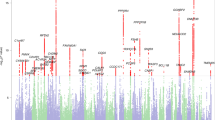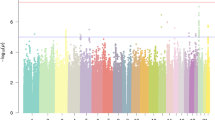Abstract
All four genes thus far linked to developmental dyslexia participate in brain development, and abnormalities in brain development are increasingly reported in dyslexia. Comparable abnormalities induced in young rodent brains cause auditory and cognitive deficits, underscoring the potential relevance of these brain changes to dyslexia. Our perspective on dyslexia is that some of the brain changes cause phonological processing abnormalities as well as auditory processing abnormalities; the latter, we speculate, resolve in a proportion of individuals during development, but contribute early on to the phonological disorder in dyslexia. Thus, we propose a tentative pathway between a genetic effect, developmental brain changes, and perceptual and cognitive deficits associated with dyslexia.
This is a preview of subscription content, access via your institution
Access options
Subscribe to this journal
Receive 12 print issues and online access
$209.00 per year
only $17.42 per issue
Buy this article
- Purchase on Springer Link
- Instant access to full article PDF
Prices may be subject to local taxes which are calculated during checkout


Similar content being viewed by others
References
Hinshelwood, J. Congenital Word-blindness (Lewis, London, 1917).
Galaburda, A.M., Sherman, G.F., Rosen, G.D., Aboitiz, F. & Geschwind, N. Developmental dyslexia: four consecutive cases with cortical anomalies. Ann. Neurol. 18, 222–233 (1985).
Drake, W.E. Clinical and pathological finding in a child with a developmental learning disability. J. Learn. Disabil. 1, 486–502 (1968).
Chang, B.S. et al. Reading impairment in the neuronal migration disorder of periventricular nodular heterotopia. Neurology 64, 799–803 (2005).
de Vasconcelos Hage, S.R. et al. Specific language impairment: linguistic annd neurobiological aspects. Arq. Neuropsiquiatr. 64, 173–180 (2006).
Galaburda, A.M., Menard, M.T. & Rosen, G.D. Evidence for aberrant auditory anatomy in developmental dyslexia. Proc. Natl. Acad. Sci. USA 91, 8010–8013 (1994).
Nicolson, R., Fawcett, A.J. & Dean, P. Dyslexia, development and the cerebellum. Trends Neurosci. 24, 515–516 (2001).
Fisher, S.E. & Francks, C. Genes, cognition and dyslexia: learning to read the genome. Trends Cogn. Sci. (in the press).
Taipale, M. et al. A candidate gene for developmental dyslexia encodes a nuclear tetratricopeptide repeat domain protein dynamically regulated in brain. Proc. Natl. Acad. Sci. USA 100, 11553–11558 (2003).
Cope, N. et al. Strong evidence that KIAA0319 on chromosome 6p is a susceptibility gene for developmental dyslexia. Am. J. Hum. Genet. 76, 581–591 (2005).
Paracchini, S. et al. The chromosome 6p22 haplotype associated with dyslexia reduces the expression of KIAA0319, a novel gene involved in neuronal migration. Hum. Mol. Genet. 15, 1659–1666 (2006).
Meng, H. et al. DCDC2 is associated with reading disability and modulates neuronal development in the brain. Proc. Natl. Acad. Sci. USA 102, 17053–17058 (2005).
Hannula-Jouppi, K. et al. The axon guidance receptor gene ROBO1 is a candidate gene for developmental dyslexia. PLoS Genet. 1, e50 (2005).
Wang, Y. et al. Dyx1c1/EKN1 plays a critical role in neuronal migration in developing neocortex. Neuroscience (in the press).
S.E. & Shaywitz, B.A. A definition of dyslexia. Ann. Dyslexia 53, 1–14 (2003).
Snowling, M.J. Dyslexia (Blackwell, Oxford, 2000).
Ramus, F. Development dyslexia: specific psychological deficits or general sensormotor dysfunction current opinion in neurobiology 13:212–218 (2003).
Wagner, R.K. & Torgesen, J.K. The nature of phonological processing and its causal role in the acquisition of reading skills. Psychol. Bull. 101, 192–212 (1987).
Stein, J. & Walsh, V. To see but not to read; the magnocellular theory of dyslexia. Trends Neurosci. 20, 147–152 (1997).
Valdois, S., Bosse, M.-L. & Tainturier, M.-J. The cognitive deficits responsible for developmental dyslexia: Review of evidence for a selective visual attentional disorder. Dyslexia 10, 339–363 (2004).
Eckert, M. Neuroanatomical markers for dyslexia: a review of dyslexia structural imaging studies. Neuroscientist 10, 362–371 (2004).
White, S. et al. A double dissociation between sensorimotor impairments and reading disability: a comparison of autistic and dyslexic children. Cogn. Neuropsychol. 23, 748–761 (2006).
Bishop, D.V.M. & Snowling, M.J. Developmental dyslexia and specific language impairment: same or different? Psychol. Bull. 130, 858–886 (2004).
Hill, E.L. Non-specific nature of specific language impairment: a review of the literature with regard to concomitant motor impairments. Int. J. Lang. Commun. Disord. 36, 149–171 (2001).
Butterworth, B. Developmental dyscalculia. in Handbook of Mathematical Cognition (ed. Campbell, J.I.D.) 455–467 (Psychology Press, New York, 2005).
Leonard, C.M. et al. Anatomical risk factors that distinguish dyslexia from SLI predict reading skill in normal children. J. Commun. Disord. 35, 501–531 (2002).
Smith, S.D., Kimberling, W.J., Pennington, B.F. & Lubs, H.A. Specific reading disability: Identification of an inherited form through linkage analysis. Science 219, 1345–1347 (1983).
Pennington, B.F. et al. Evidence for major gene transmission of developmental dyslexia. J. Am. Med. Assoc. 266, 1527–1534 (1991).
Cardon, L.R. et al. Quantitative trait locus for reading disability on chromosome 6. Science 266, 276–279 (1994).
Allen, K.M., Gleeson, J.G., Shoup, S.M. & Walsh, C.A.A. YAC contig in Xq22.3-q23, from DXS287 to DXS8088, spanning the brain-specific genes doublecortin (DCX) and PAK3. Genomics 52, 214–218 (1998).
des Portes, V. et al. doublecortin is the major gene causing X-linked subcortical laminar heterotopia (SCLH). Hum. Mol. Genet. 7, 1063–1070 (1998).
Deuel, T.A. et al. Genetic interactions between doublecortin and doublecortin-like kinase in neuronal migration and axon outgrowth. Neuron 49, 41–53 (2006).
Koizumi, H., Tanaka, T. & Gleeson, J.G. Doublecortin-like kinase functions with doublecortin to mediate fiber tract decussation and neuronal migration. Neuron 49, 55–66 (2006).
Coquelle, F.M. et al. Common and divergent roles for members of the mouse DCX superfamily. Cell Cycle 5, 976–983 (2006).
Wigg, K.G. et al. Support for EKN1 as the susceptibility locus for dyslexia on 15q21. Mol. Psychiatry 9, 1111–1121 (2004).
Chapman, N.H. et al. Linkage analyses of four regions previously implicated in dyslexia: confirmation of a locus on chromosome 15q. Am. J. Med. Genet. B Neuropsychiatr. Genet. 131, 67–75 (2004).
Marino, C. et al. A family-based association study does not support DYX1C1 on 15q21.3 as a candidate gene in developmental dyslexia. Eur. J. Hum. Genet. 13, 491–499 (2005).
LoTurco, J.J., Wang, Y. & Paramasivam, M. Neuronal migration and dyslexia susceptibility. in The Dyslexic Brain: New Pathways in Neuroscience Discovery (ed. Rosen, G.D.) 119–128 (Lawrence Erlbaum Associates, Mahwah, New Jersey, 2006).
Erskine, L. et al. Retinal ganglion cell axon guidance in the mouse optic chiasm: expression and function of robos and slits. J. Neurosci. 20, 4975–4982 (2000).
Yuan, W. et al. The mouse SLIT family: secreted ligands for ROBO expressed in patterns that suggest a role in morphogenesis and axon guidance. Dev. Biol. 212, 290–306 (1999).
Zhu, Y., Li, H., Zhou, L., Wu, J.Y. & Rao, Y. Cellular and molecular guidance of GABAergic neuronal migration from an extracortical origin to the neocortex. Neuron 23, 473–485 (1999).
Rutter, M. et al. Sex differences in developmental reading disability: new findings from 4 epidemiological studies. J. Am. Med. Assoc. 291, 2007–2012 (2004).
Rosen, G.D., Herman, A.E. & Galaburda, A.M. Sex differences in the effects of early neocortical injury on neuronal size distribution of the medial geniculate nucleus in the rat are mediated by perinatal gonadal steroids. Cereb. Cortex 9, 27–34 (1999).
Rosen, G.D., Burstein, D. & Galaburda, A.M. Changes in efferent and afferent connectivity in rats with cerebrocortical microgyria. J. Comp. Neurol. 418, 423–440 (2000).
Denenberg, V.H., Sherman, G.F., Schrott, L.M., Rosen, G.D. & Galaburda, A.M. Spatial learning, discrimination learning, paw preference and neocortical ectopias in two autoimmune strains of mice. Brain Res. 562, 98–104 (1991).
Rosen, G.D., Waters, N.S., Galaburda, A.M. & Denenberg, V.H. Behavioral consequences of neonatal injury of the neocortex. Brain Res. 681, 177–189 (1995).
Peiffer, A.M., Friedman, J.T., Rosen, G.D. & Fitch, R.H. Impaired gap detection in juvenile microgyric rats. Brain Res. Dev. Brain Res. 152, 93–98 (2004).
Fitch, R.H., Tallal, P., Brown, C., Galaburda, A.M. & Rosen, G.D. Induced microgyria and auditory temporal processing in rats: a model for language impairment? Cereb. Cortex 4, 260–270 (1994).
Clark, M.G., Rosen, G.D., Tallal, P. & Fitch, R.H. Impaired two-tone processing at rapid rates in male rats with induced microgyria. Brain Res. 871, 94–97 (2000).
Acknowledgements
This work was supported by US National Institutes of Health grant HD20806 and by the The Dyslexia Foundation, and by grants from the Ville de Paris and the European Commission NEURODYS Project.
Author information
Authors and Affiliations
Ethics declarations
Competing interests
The authors declare no competing financial interests.
Rights and permissions
About this article
Cite this article
Galaburda, A., LoTurco, J., Ramus, F. et al. From genes to behavior in developmental dyslexia. Nat Neurosci 9, 1213–1217 (2006). https://doi.org/10.1038/nn1772
Published:
Issue Date:
DOI: https://doi.org/10.1038/nn1772
This article is cited by
-
Hypothesis-driven genome-wide association studies provide novel insights into genetics of reading disabilities
Translational Psychiatry (2022)
-
Brain dynamics of (a)typical reading development—a review of longitudinal studies
npj Science of Learning (2021)
-
White matter deficits correlate with visual motion perception impairments in dyslexic carriers of the DCDC2 genetic risk variant
Experimental Brain Research (2021)
-
Poor neural and perceptual phoneme discrimination during acoustic variation in dyslexia
Scientific Reports (2020)
-
The Importance of Research on Integrating Transcranial Direct Current Stimulation (TDCS) with Evidence-Based Reading Interventions
Journal of Pediatric Neuropsychology (2020)



